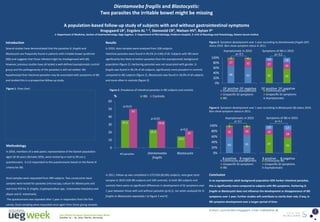Parasitposter uegw
- 1. Dientamoeba fragilis and Blastocystis: Two parasites the irritable bowel might be missing A population-based follow-up study of subjects with and without gastrointestinal symptoms Krogsgaard 1, LR Engsbro AL 1, 2, Stensvold 3, CR Nielsen 3, HV Bytzer 1 P 1: Department of Medicine, Section of Gastroenterology, K├Ėge Sygehus. 2: Department of Microbiology, Hvidovre Hospital, 3: Unit of Mycology and Parasitology, Statens Serum Institut Figure 3. Symptom development over 1 year according to Dientamoeba fragilis (DF) status 2010. Bars show symptom status in 2011. Introduction Results Several studies have demonstrated that the parasites D. fragilis and In 2010, stool samples were analyzed from 328 subjects. Blastocystis are frequently found in patients with irritable bowel syndrome Intestinal parasites were found in 44,5% (n=146) of all. Subjects with IBS were (IBS) and suggests that those infested might by misdiagnosed with IBS. significantly less likely to harbor parasites than the asymptomatic background However, previous studies have all lacked a well-defined asymptomatic control population (figure 2). Harboring parasites was not associated with gender. D. group and the pathogenecity of the parasites is still not settled. We fragilis was found in 30,1% of all subjects; significantly more prevalent in controls hypothesised that intestinal parasites may be associated with symptoms of IBS compared to IBS subjects (figure 2). Blastocystis was found in 18,9% of all subjects and studied this in a prospective follow-up study. and more often in controls (figure 2). Figure 1. Flow chart 100% 80% 60% 40% 20% 0% IBS 60 50 30 35.5 In 2010, members of a web-panel, representative of the Danish population aged 18-49 years (females 50%), were invited by e-mail to fill out a 18 27 26 62 56 DF positive DF negative Continously IBS Unspecific GI symptoms Asymptomatic p> 0,1 p=0,0 22 5 6 80% 35 29 13 20 60 65 67 60% 40% 20% Dientamoeba fragilis Symptoms of IBS in 2010 100% 0 All parasites 12 p> 0,1 14.5 10 Methodology Asymptomatic in 2010 p=0,03 34.8 23.4 20 Symptoms of IBS in 2010 p> 0,1 Figure 4. Symptom development over 1 year according to Blastocystis (B) status 2010. Bars show symptom status in 2011. 50 40 62 Continously asymptomatic Unspecific GI symptoms IBS Controls p=0,01 68 DF positive DF negative Figure 2. Prevalence of intestinal parasites in IBS subjects and controls % Asymptomatic in 2010 p> 0,1 5 6 27 32 Blastocystis questionnaire. 6.112 responded to the questionnaire based on the Rome III criteria for IBS. 17 28 56 0% B positive B negative Continously asymptomatic Unspecific GI symptoms IBS B positive B negative Continously IBS Unspecific GI symptoms Asymptomatic In 2011, follow-up was completed in 275/328 (83,8%) subjects, who gave stool Stool samples were requested from 499 subjects. Two consecutive stool samples were tested for parasites (microscopy, culture for Blastocystis and real-time PCR for D. fragilis, Cryptosporidium spp., Entamoeba histolytica and dispar and G. intestinalis). The questionnaire was repeated after 1 year in responders from the first survey. Stool sampling were requested once again from those giving samples sin 2010. Conclusion samples in 2010 (106 IBS subjects and 169 controls). In both IBS subjects and In an asymptomatic adult background population 50% harbor intestinal parasites, controls there were no significant differences in development of GI symptoms over this is significantly more compared to subjects with IBS symptoms. Harboring D. 1 year between those with and without parasites (p>0,1), nor when analyzed for D. fragilis or Blastocystis does not influence the development or disappearance of IBS fragilis or Blastocystis separately ( se figure 3 and 4) . symptoms over 1 year. Further studies will contribute to clarify their role, if any, in IBS symptom development over a longer period of time. Contact: Laura Rindom Krogsgaard. Email: lrk@dadlnet.dk
